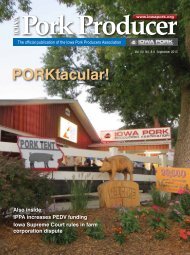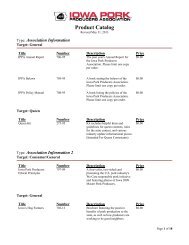Pork Congress 2012 - Iowa Pork Producers Association
Pork Congress 2012 - Iowa Pork Producers Association
Pork Congress 2012 - Iowa Pork Producers Association
Create successful ePaper yourself
Turn your PDF publications into a flip-book with our unique Google optimized e-Paper software.
is generated within the biofilter<br />
when heat-producing biochemical<br />
reactions occur – for example,<br />
when the ammonia is converted<br />
into nitrate by bacteria. The heat<br />
from the biofilter is also routed to<br />
the heat exchanger.<br />
Maintaining the appropriately<br />
high temperature is important<br />
for chicken and swine operations,<br />
because it is essential for rearing<br />
chicks and piglets to maturity.<br />
“The technology is best suited<br />
for use when an operation wants<br />
to vent a facility that has high<br />
ammonia concentrations and pump<br />
in cleaner air in preparation for<br />
a fresh batch of chicks or piglets<br />
– particularly in cold weather.<br />
It is also suitable for use when<br />
supplemental heat is required for<br />
raising the young animals,” says Dr.<br />
Sanjay Shah, an associate professor<br />
of biological and agricultural<br />
engineering at NC State and lead<br />
author of a paper describing the<br />
research. For this to be feasible,<br />
it would be necessary to replace<br />
a couple of the conventional<br />
cold weather ventilation fans<br />
with higher-pressure fans. Shah<br />
explains that the technology is<br />
not compatible with summer<br />
ventilation using tunnel-fans,<br />
because of the high cost and<br />
choking effect on the fans.<br />
Shah says the researchers focused<br />
on ammonia removal because:<br />
it is released from chicken and<br />
swine barns in large quantities;<br />
it contributes to nutrient loading<br />
problems such as hypoxia; it is an<br />
indirect contributor to greenhouse<br />
gases (GHGs) because it can break<br />
down into the potent GHG nitrous<br />
oxide in the ground; and because it<br />
is a precursor to very fine particulate<br />
matter, which contributes to haze<br />
and public health problems, such as<br />
asthma.<br />
Researchers showed that their<br />
design is effective under real-world<br />
conditions, operating their prototype<br />
in a 5,000-bird chicken facility. The<br />
prototype removed up to 79 percent<br />
of ammonia and reduced the<br />
energy needed to maintain the<br />
necessary temperature in the<br />
facility – recovering as much as<br />
8.3 kilowatts of heat.<br />
“We plan to continue working<br />
to improve the system design<br />
in order to make it even more<br />
efficient,” Shah says.<br />
March <strong>2012</strong><br />
13













